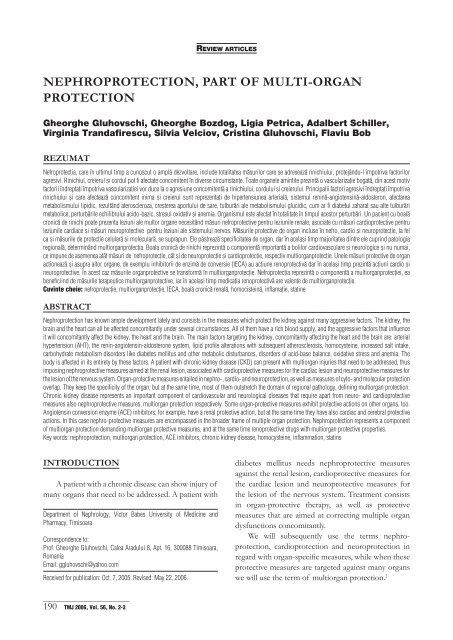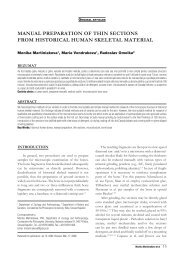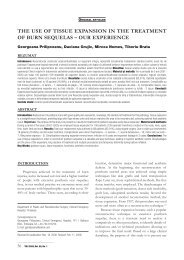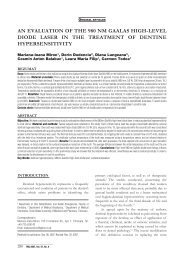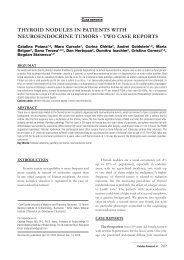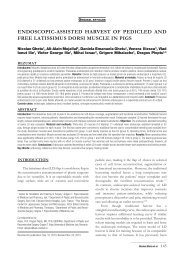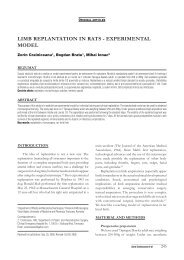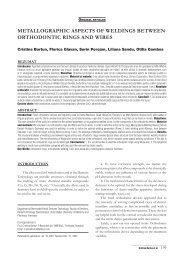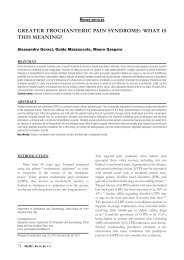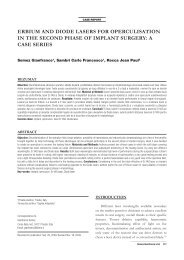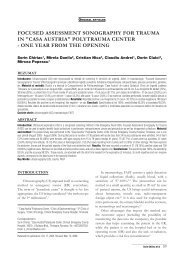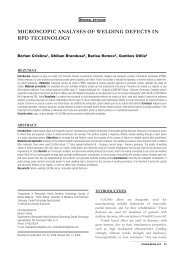nEPHroProtEction, Part oF MULti-orGan ProtEction
nEPHroProtEction, Part oF MULti-orGan ProtEction
nEPHroProtEction, Part oF MULti-orGan ProtEction
You also want an ePaper? Increase the reach of your titles
YUMPU automatically turns print PDFs into web optimized ePapers that Google loves.
EZUMat<br />
abstract<br />
introdUction<br />
A patient with a chronic disease can show injury of<br />
many organs that need to be addressed. A patient with<br />
Department of Nephrology, Victor Babes University of Medicine and<br />
Pharmacy, Timisoara<br />
Correspondence to:<br />
Prof. Gheorghe Gluhovschi, Calea Aradului 8, Apt. 16, 300088 Timisoara,<br />
Romania<br />
Email: ggluhovschi@yahoo.com<br />
Received for publication: Oct. 7, 2005. Revised: May 22, 2006.<br />
_____________________________<br />
190 TMJ 2006, Vol. 56, No. 2-3<br />
Review aRticleS<br />
<strong>nEPHro<strong>ProtEction</strong></strong>, <strong>Part</strong> <strong>oF</strong> <strong>MULti</strong>-<strong>orGan</strong><br />
<strong>ProtEction</strong><br />
Gheorghe Gluhovschi, Gheorghe Bozdog, ligia Petrica, adalbert Schiller,<br />
virginia trandafirescu, Silvia velciov, cristina Gluhovschi, Flaviu Bob<br />
Nefroprotec]ia, care n ultimul timp a cunoscut o ampl\ dezvoltare, include totalitatea m\surilor care se adreseaz\ rinichiului, protejndu-l mpotriva factorilor<br />
agresivi. Rinichiul, creierul [i cordul pot fi afectate concomitent n diverse circumstan]e. Toate organele amintite prezint\ o vasculariza]ie bogat\, din acest motiv<br />
factorii ndrepta]i mpotriva vasculariza]iei vor duce la o agresiune concomitent\ a rinichiului, cordului [i creierului. Principalii factori agresivi ndrepta]i mpotriva<br />
rinichiului [i care afecteaz\ concomitent inima [i creierul sunt reprezenta]i de hipertensiunea arterial\, sistemul renin\-angiotensin\-aldosteron, afectarea<br />
metabolismului lipidic, rezultnd ateroscleroza, cre[terea aportului de sare, tulbur\ri ale metabolismului glucidic, cum ar fi diabetul zaharat sau alte tulbur\ri<br />
metabolice, perturb\rile echilibrului acido-bazic, stresul oxidativ [i anemia. Organismul este afectat n totalitate n timpul acestor perturb\ri. Un pacient cu boal\<br />
cronic\ de rinichi poate prezenta leziuni ale multor organe necesitnd m\suri nefroprotective pentru leziunile renale, asociate cu m\suri cardioprotective pentru<br />
leziunile cardiace [i m\suri neuroprotective pentru leziuni ale sistemului nervos. M\surile protective de organ incluse n nefro, cardio [i neuroprotec]ie, la fel<br />
ca [i m\surile de protec]ie celular\ [i molecular\, se suprapun. Ele p\streaz\ specificitatea de organ, dar n acela[i timp majoritatea dintre ele cuprind patologia<br />
regional\, determinnd multiorganprotec]ia. Boala cronic\ de rinichi reprezint\ o component\ important\ a bolilor cardiovasculare [i neurologice [i nu numai,<br />
ce impune de asemenea att m\suri de nefroprotec]ie, ct [i de neuroprotec]ie [i cardioprotec]ie, respectiv multiorganprotec]ie. Unele m\suri protective de organ<br />
ac]ioneaz\ [i asupra altor organe, de exemplu inhibitorii de enzim\ de conversie (IECA) au ac]iune renoprotectiv\ dar n acela[i timp prezint\ ac]iuni cardio [i<br />
neuroprotective. n acest caz m\surile organprotective se transform\ n multiorganprotec]ie. Nefroprotec]ia reprezint\ o component\ a multiorganprotec]iei, ea<br />
beneficiind de m\surile terapeutice multiorganprotective, iar n acela[i timp medica]ia renoprotectiv\ are valen]e de multiorganprotec]ie.<br />
Cuvinte cheie: nefroprotec]ie, multiorganprotec]ie, IECA, boal\ cronic\ renal\, homocistein\, inflama]ie, statine<br />
Nephroprotection has known ample development lately and consists in the measures which protect the kidney against many aggressive factors. The kidney, the<br />
brain and the heart can all be affected concomitantly under several circumstances. All of them have a rich blood supply, and the aggressive factors that influence<br />
it will concomitantly affect the kidney, the heart and the brain. The main factors targeting the kidney, concomitantly affecting the heart and the brain are: arterial<br />
hypertension (AHT), the renin-angiotensin-aldosterone system, lipid profile alterations with subsequent atherosclerosis, homocysteine, increased salt intake,<br />
carbohydrate metabolism disorders like diabetes mellitus and other metabolic disturbances, disorders of acid-base balance, oxidative stress and anemia. The<br />
body is affected in its entirety by these factors. A patient with chronic kidney disease (CKD) can present with multiorgan injuries that need to be addressed, thus<br />
imposing nephroprotective measures aimed at the renal lesion, associated with cardioprotective measures for the cardiac lesion and neuroprotective measures for<br />
the lesion of the nervous system. Organ-protective measures entailed in nephro-, cardio- and neuroprotection, as well as measures of cyto- and molecular protection<br />
overlap. They keep the specificity of the organ, but at the same time, most of them outstretch the domain of regional pathology, defining multiorgan protection.<br />
Chronic kidney disease represents an important component of cardiovascular and neurological diseases that require apart from neuro- and cardioprotective<br />
measures also nephroprotective measures, multiorgan protection respectively. Some organ-protective measures exhibit protective actions on other organs, too.<br />
Angiotensin conversion enzyme (ACE) inhibitors, for example, have a renal protective action, but at the same time they have also cardiac and cerebral protective<br />
actions. In this case nephro-protective measures are encompassed in the broader frame of multiple organ protection. Nephroprotection represents a component<br />
of multiorgan protection demanding multiorgan protective measures, and at the same time renoprotective drugs with multiorgan protective properties.<br />
Key words: nephroprotection, multiorgan protection, ACE inhibitors, chronic kidney disease, homocysteine, inflammation, statins<br />
diabetes mellitus needs nephroprotective measures<br />
against the renal lesion, cardioprotective measures for<br />
the cardiac lesion and neuroprotective measures for<br />
the lesion of the nervous system. Treatment consists<br />
in organ-protective therapy, as well as protective<br />
measures that are aimed at correcting multiple organ<br />
dysfunctions concomitantly.<br />
We will subsequently use the terms nephroprotection,<br />
cardioprotection and neuroprotection in<br />
regard with organ-specific measures, while when these<br />
protective measures are targeted against many organs<br />
we will use the term of multiorgan protection. 1
Organ-protective measures focus on a single<br />
organ, such as nephroprotective, cardioprotective or<br />
neuroprotective measures. Some organ-protective<br />
measures exhibit protective actions on other organs,<br />
too. ACE inhibitors, for example, have a renal<br />
protective action, but at the same time they also have<br />
cardiac and cerebral protective actions. In this case<br />
organ-protective measures cross into to the field of<br />
multiple organ or multi-organ protection.<br />
The issue is to establish the common features of<br />
the kidney, the brain and the heart, in order to explain<br />
the similar lesions that impose common therapeutic<br />
protective measures. The circulatory system, with<br />
the heart and major blood vessels at its center<br />
will ensure blood flow to the periphery, including<br />
heart, kidney and brain. The heart depends on the<br />
coronary vessels to allow an adequate functioning.<br />
The brain has a well represented blood supply, which<br />
can not adapt to hypoxia, and the renal blood flow<br />
represents approximately 20% of the circulating<br />
volume. Consequently different alterations of the<br />
circulatory system will impact on these organs. For<br />
example, hypertension concomitantly affects kidney,<br />
heart and brain. The use of ACE inhibitors and AII<br />
receptor blockers will have a complex nephro-, cardio-<br />
and neuroprotective effect. Lesions secondary to<br />
atherosclerosis, as well as inflammatory diseases will<br />
have an effect on the vascular endothelium. The use of<br />
statins will influence the lipid profile and consequently<br />
the effect of the latter on coronary, renal and cerebral<br />
blood flow. Diet will have similar effects. Likewise,<br />
sulodexide exerts a protective effect on the vascular<br />
endothelium by correcting glycosaminoglycans.<br />
Glucose metabolism changes will also influence<br />
the body as a whole. They are reflected metabolically<br />
or hemodinamically by means of secondary alterations<br />
of lipid metabolism. The approach of glucose<br />
metabolism will have consequences on kidney, heart<br />
and brain.<br />
Hypoxia secondary to anemia that accompanies<br />
advanced chronic kidney disease concomitantly afflicts<br />
the heart. Silverberg describes a triad: anemia, chronic<br />
kidney disease and heart disease, with overlapping<br />
pathology. 2 Hypoxia also affects the brain producing<br />
functional alterations at this level. Correction<br />
of anemia of chronic kidney disease through<br />
nephroprotective measures which consist of iron,<br />
folic acid and erythropoietin will have consequences<br />
Figure 1. Nephroprotection - component of multiorgan protection, in relationship with cardioprotection, neuroprotection, cytoprotection and molecular protection.<br />
_____________________________<br />
Gheorghe Gluhovschi et al 191
on the kidney by improving the reduced production<br />
of erythropoietin and its function, but will also<br />
impact the heart, by improving cardiac disease<br />
accompanied by renal and cerebral impairment.<br />
Other factors which need to be addressed are<br />
oxidative stress, excess salt intake, clotting disorders,<br />
smoking, and hyperhomocysteinemia. These are<br />
measures that encompass many organs, mainly the<br />
kidney, heart and brain.<br />
Uremia is a microinflammatory state and requires<br />
renal replacement therapy, thereby improving renal<br />
and cardiac injury, as well as that of other tissues and<br />
organs. Because these factors are beyond single organ<br />
protection they belong to multiorgan protection.<br />
Therefore, overlapping pathology which afflicts<br />
many systems can be reframed as multiorgan<br />
protection, allowing for a unitary approach. (Fig. 1)<br />
Cytoprotection and molecular protective measures<br />
could be added.<br />
cHronic kidnEy disEasE and<br />
cardio<strong>ProtEction</strong><br />
Chronic kidney disease is accompanied by<br />
cardiovascular involvement; contributing factors to<br />
this condition are elevated blood pressure, metabolic<br />
disturbances with subsequent coronary atherosclerosis,<br />
endothelial damage, hypoxia secondary to anemia,<br />
oxidative stress, etc.<br />
It is assumed that for a patient with chronic kidney<br />
disease the probability to reach end-stage renal disease<br />
(ESRD) should be lower then the probability to die<br />
from cardiovascular complications (K/DOQI 2002). 3<br />
Atherosclerosis starts during the first stages of chronic<br />
kidney disease and worsens during hemodialysis.<br />
Locatelli et al. have shown that cardiovascular<br />
diseases play a major role in the morbidity and the<br />
mortality of patients undergoing renal replacement<br />
therapy, representing 50% of all cause mortality rate. 4<br />
Rabelink et al. consider cardiovascular death in patients<br />
with ESRD to be probably the highest encountered<br />
in medicine. 5 CKD is considered an independent<br />
risk factor for cardiovascular diseases. 6 Mortality rate<br />
related with cardiovascular diseases increases with<br />
declining glomerular filtration rate (GFR). 7-9<br />
CKD defined as reduced GFR below 60 ml/<br />
min/sqm has been designated as a major risk factor<br />
for cardiovascular disease in JNC VII and the<br />
European Society of Hypertension. 10 CKD represents<br />
also an independent factor for the progression of<br />
atherosclerosis. Atherosclerotic lesions in the thoracic<br />
aorta have been significantly higher in uraemic E-/-<br />
_____________________________<br />
192 TMJ 2006, Vol. 56, No. 2-3<br />
mice then in non-uremic controls. CKD increases<br />
arterial calcifications at sites of the internal wall<br />
of vessels affected by atherosclerosis as well as at<br />
atheroma-free sites.<br />
CKD seems to have systemic consequences;<br />
therefore it can be considered a systemic disorder. It<br />
is estimated that out of 8 million Americans affected<br />
by CKD who have not undergone renal replacement<br />
therapy, 80% will die of cardiovascular causes. The<br />
probability of cardiovascular death is higher then that<br />
of reaching ESRD even for patients with mild and<br />
moderate renal function impairment. 8,11<br />
Some of the mechanisms encountered in CKD<br />
are known to generate systemic alterations. It is<br />
considered that kidney has a central part in controlling<br />
blood pressure through regulation of Na absorbtion<br />
and through renalase- a soluble monoaminooxidase<br />
which metabolises catecholamines. The plasmatic<br />
concentration of renalase is reduced in patients with<br />
ESRD, inducing an increase in arterial blood pressure<br />
and changes of cardiac function. 12<br />
Patients with cardiovascular diseases frequently<br />
show renal injury, which has not yet been studied<br />
in its complexity. Nephroangiosclerosis is a<br />
common occurrence during arterial hypertension.<br />
Renal involvement has also been signaled in many<br />
cardiovascular diseases, although there is a relative<br />
paucity of data regarding the impact of kidney lesions<br />
in cardiovascular diseases.<br />
In a study performed by Adler et al. who have<br />
followed up 5097 patients over a period of longer<br />
then 10 years, with type 2 diabetes, it has been proven<br />
that the risk of death through cardiovascular disease is<br />
greater then that of developing ESRD. 11<br />
Lately, the term of cardio-renal failure has gained<br />
momentum. This draws attention to the simultaneous<br />
and often severe affection of both cardiac and renal<br />
function. 13<br />
Cardioprotective measures represent cardinal<br />
elements during the treatment of CKD. Because the<br />
majority of renal diseases show an involvement of<br />
the cardiovascular system, mainly during ESRD, they<br />
are as mandatory as nephroprotective measures. By<br />
targeting both systems they sometimes overlap.<br />
tHE kidnEy and tHE vascULar<br />
EndotHELiUM<br />
The kidney is an organ which can target the<br />
vascular endothelium in different ways:<br />
- Hypertension of renal origin through elevated<br />
blood pressure, AII, endothelin and vasopressin.
- Microinflamatory processes:<br />
• CKD represents a chronic inflammatory state<br />
per se.<br />
• End stage renal disease generates also chronic<br />
inflammation which affects the vascular bed. It is<br />
regarded by Luke et al. as a chronic vasculopathic state;<br />
with malnutrition as a major contributor. 14<br />
• Atheromatosis, a common occurrence in CKD,<br />
mainly in the advanced stages, is presently considered<br />
a microinflammatory process.<br />
- Nephrotic syndrome is accompanied by<br />
disturbances of lipid metabolism which affect the<br />
vascular endothelium.<br />
CKDs, most commonly the nephrotic syndrome,<br />
are accompanied by clotting disorders, which lead to<br />
an increase in the procoagulant activity. Renal diseases<br />
also show disturbances in the synthesis of NO at<br />
the level of arterial blood vessels, of cGMP and of<br />
glycosaminoglycans. Asymmetrical dimethylarginine<br />
(ADMA), an endogenous inhibitor of nitric oxide,<br />
accumulates during CKD following functional<br />
decline. ADMA accelerates endothelial senescence<br />
by inhibiting telomerase activity, thus favoring<br />
atherosclerosis. 15<br />
According to Schiffrin, microalbuminuria can<br />
evolve in hypertensive patients parallel to endothelial<br />
damage and AHT progression. 16<br />
In renal disease drugs with endothelial protective<br />
properties are employed, such as sulodexide. These<br />
drugs have nephroprotective effect by reestablishing the<br />
balance of renal glycosaminoglycans. At the same time<br />
they reduce proteinuria exhibiting a nephroprotective<br />
effect. As they target vascular endothelium in general<br />
they exert multiorgan protective actions.<br />
ProtEinUria and nEPHroPatHy<br />
Proteinuria is strongly related to kidney disease<br />
progression. It is involved in tubulo- interstitial lesions<br />
from glomerular diseases.<br />
Inflammatory glomerular diseases are accompanied<br />
by the excretion of serum proteins. These can cause<br />
tubulo-interstitial damage by different pathways:<br />
- Protein overload induces NF-KB activation in<br />
proximal tubular cells.<br />
- Elimination of cytokines and chemokines<br />
produced in the course of the inflammatory process<br />
at the level of the glomerulus and other mediators of<br />
the inflammation.<br />
- Elimination in the urine of components of the<br />
complement system.<br />
- Synthesis and release of chemokines by tubular<br />
cells, which will attract macrophages.<br />
- Filtered proteins in the glomerulus lead to<br />
proliferation of the proximal tubular cells, which will<br />
cause attraction of macrophages<br />
- Filtered proteins in the glomerulus lead to the<br />
proliferation of proximal tubular cells associated<br />
with the increase of the synthesis of vasoactive and<br />
proinflammatory substances.<br />
At the same time, proteinuria has more general<br />
effects on the circulatory system with an impact on<br />
brain, heart and kidney. Heavy proteinuria during the<br />
course of nephrotic syndrome can cause important<br />
tubulo-interstitial inflammatory lesions. They will<br />
also concomitantly affect the lipid profile leading<br />
to increased levels of triglycerides and VLDL<br />
cholesterol, and reduced serum lipoproteinlipase<br />
activity. Proper conditions for the development<br />
of atherosclerosis within the vascular walls will<br />
be created. Consequently, patients with nephrotic<br />
syndrome will show more often atherosclerotic<br />
changes at the level of the coronary arteries, as well<br />
as cerebral and renal arteries. Moreover, patients with<br />
advanced CKD show lipid profile disturbances, which<br />
progress with the evolution of the disease, with the<br />
predominance of hypertriglyceridaemia, which could<br />
explain atherosclerosis in these patients.<br />
Even mild proteinuria or microalbuminuria could<br />
play a role in the pathological processes taking place<br />
at the level of the vascular tree. In diabetes mellitus it<br />
correlates with the endothelial lesions.<br />
anEMia <strong>oF</strong> rEnaL oriGin and<br />
<strong>nEPHro<strong>ProtEction</strong></strong><br />
Reduction of the renal parenchyma creates a<br />
relative deficiency of erythropoietin with subsequent<br />
anemia. The severity of anemia grossly approximates<br />
the severity of renal dysfunction and reduction of<br />
nephron mass.<br />
Anemia is a common element of advanced CKD but<br />
also accompanies mild impairment of renal function.<br />
It is considered that a patient with mild or moderate<br />
CKD has a higher propensity to die of cardiovascular<br />
cause then of reaching ESRD. Conversely, a patient with<br />
heart disease frequently develops kidney involvement<br />
which can aggravate cardiac disease. If associated to<br />
both conditions, anemia is a worsening factor.<br />
Strippoli et al., by analyzing many clinical trials<br />
of patients with variable degree of cardio-vascular<br />
involvement, observed a higher mortality rate in those<br />
with concomitant renal and heart disease, related to<br />
hemoglobin levels. 17<br />
_____________________________<br />
Gheorghe Gluhovschi et al 193
Anemia is associated to left ventricle hypertrophy,<br />
increased vascular morbidity, progressive decline of<br />
renal function, decrease of cognitive ability, etc.<br />
Anemia acts as a multiplier of overall mortality<br />
at any hemoglobin decline below 12 g/dl. Mortality<br />
increases in patients with CKD and heart disease.<br />
Cardiovascular risk factors play a key role in the<br />
development of CKD and vice-versa. 18 The metabolic<br />
syndrome can lead to cardiovascular disease and kidney<br />
impairment without overt diabetes.<br />
The addition of anemia to CKD is associated with<br />
an increased risk for stroke independently of other risk<br />
factors. This has been shown in ARIC (Atherosclerosis<br />
risk in communities) on 13716 investigated persons. 19<br />
An increase in hemoglobin to levels above 10 g/dl is<br />
related to an improvement of cardiac performance<br />
and the regression of heart enlargement. 20,21<br />
concoMitant rEnaL, cardiac<br />
and cErEbraL injUry<br />
Renal, cardiac and cerebral organ lesions and the<br />
therapeutic measures with for them have been the<br />
object of numerous studies, some of them multicentric<br />
clinical trials. These studies are aimed either towards<br />
a single organ (heart, kidney, brain) or an association<br />
of two organs (kidney and heart, heart and brain) or<br />
investigated an association of the three organs: kidney,<br />
heart and brain, as well as other associations. A small<br />
number of studies are addressed to the association of<br />
the three organs: brain, heart, kidney.<br />
The HOPE study (Heart Outcome Prevention<br />
Evaluation Study) has demonstrated the effect of<br />
ramipril (angiotensin converting enzyme inhibitor)<br />
compared to placebo in patients at high risk of<br />
cardiovascular events. Ramipril reduced the rates<br />
of myocardial infarction, stroke and cardiovascular<br />
death. 22<br />
The concomitant injury of more than one organ<br />
related to renal disorders has been demonstrated<br />
in two of our studies. The first was performed on a<br />
group of 547 patients with chronic renal failure in<br />
the predialytic phase, admitted to the Department of<br />
Nephrology, Timisoara, between 1991 and 2002; 191<br />
of them were followed up during a mean period of<br />
19.38 ± 23.55 months, concerning the relationship with<br />
hypertension. We observed that 458 patients (83.72%)<br />
had hypertension, 288 of them had hypertensive<br />
cardiopathy (56.65%) and 8 cases had a history of<br />
stroke.<br />
Hypertension is a proven risk factor. Patients<br />
with CRF and hypertension have a degradation<br />
_____________________________<br />
194 TMJ 2006, Vol. 56, No. 2-3<br />
rate of renal function (delta creatinine clearance)<br />
higher than patients without hypertension: 21.97 ±<br />
18.68 ml/min as compared to 15.6 ± 10.5 ml/min<br />
(p
ACE inhibitors and AII receptor blockers have a<br />
hypotensive effect with subsequent renal, cardiac and<br />
cerebroprotective actions. At the same time they exert<br />
an antiproteinuric effect, mainly on renal blood flow.<br />
Concomitantly, statins have a lipid-lowering effect<br />
which acts protectively on the coronary cerebral and<br />
renal blood supply.<br />
Another approach is the association of multiple<br />
drugs targeting different risk factors, resulting in<br />
multiorgan protection. Thereby, complex protection<br />
can be achieved, because many risk factors are shared<br />
by the kidney, heart and brain. The most commonly<br />
prescribed associations are:<br />
- Single pill: aspirin, statin, 3 blood pressure<br />
lowering drugs at half dosage, and folic acid as<br />
proposed by Law et al. 25<br />
- A super-pill: ACE inhibitors, ARBs, diuretics,<br />
non-dihydropyridine calcium channel blockers. 26<br />
- A combination of aspirin, lovastatin, lisinopril<br />
which has been named ASTACE (aspirin, statin, ACE<br />
inhibitor). 27<br />
We will briefly summarize some of the drugs<br />
with nephroprotective effect which possess cardiac,<br />
neurological and also multiorgan protective actions.<br />
These drugs also exert cytoprotective and molecular<br />
protective effects.<br />
ACE inhibitors and Angiotensin II receptor<br />
blockers (ARB)<br />
They exert actions on the vascular tree at the level<br />
of different organs ensuring renal, cardiac and cerebral<br />
protection. Blood pressure lowering is their main<br />
action. These drugs have a cardioprotective effect by<br />
improving cardiac function after myocardial infarction,<br />
reducing cardiovascular morbidity and mortality as<br />
shown in HOPE study. 22 A better effect on morbidity<br />
and mortality has been reported with ARBs compared<br />
to other hypotensive drugs at the same level of blood<br />
pressure reduction. 28<br />
ACE inhibitors and ARBs also demonstrated<br />
neuroprotective action - prevention of stroke, and<br />
nephroprotective effects - they slow the progression<br />
of renal disease. 6<br />
The antiproteinuric effect is produced by<br />
lowering intraglomerular pressure and modification<br />
of glomerular capillary permeability and increases<br />
upon association to ARBs of ACE inhibitors. 29,30 They<br />
have a nephroprotective effect in both hypertensive<br />
and normotensive individuals, which could be partly<br />
explained by the reduction of proteinuria. 31 ARBs have<br />
a positive effect on renal fibrosis by collagen synthesis<br />
blockade. 32<br />
Treatment with statins<br />
Their main action consists of blockade of<br />
cholesterol synthesis, thereby exerting strong lipidlowering<br />
effect. Besides, statins have pleiotropic<br />
effects, such as the following: reduction of NFkB<br />
activation, anti-inflammatory action, anti-oxidant<br />
effect, hypotensive effect, by down regulation of AII<br />
receptor type I, improvement of endothelial function<br />
by means of up-regulating endothelial cell NO<br />
synthase, reduction of reactive oxygen species in the<br />
vascular wall, and antiproteinuric effect: cerivastatin has<br />
been reported to reduce microalbuminuria in patients<br />
with type II diabetes mellitus. 33 The blood pressure<br />
lowering effect can contribute to the reduction of<br />
albuminuria. The combination of statins with ACE<br />
inhibitors diminishes glomerulosclerosis and protein<br />
excretion in the Heymann nephritis model in rats,<br />
while ACE-inhibitors or statin monotherapy has<br />
limited effects. 34<br />
HMG-CoA reductase inhibitors improve diabetic<br />
nephropathy through pleiotropic effects in rats. 35<br />
Lovastatin inhibits mesangial cell proliferation in<br />
rats, while cerivastatin prevents ICAM 1 expression. 36<br />
Statins selectively block LFA-1 mediated adhesion and<br />
costimulation of lymphocytes.<br />
Erythropoietin (EPO)<br />
It is a cytokine mainly produced by the kidney with<br />
stimulating effects on erythropoiesis. Furthermore,<br />
eryhtropoietin demonstrated tissue-protective effects in<br />
an experimental model of ischemic-induced neuronal,<br />
retinal, cardiac and renal lesions. 37 With the exception<br />
of its stimulating effect on erythropoiesis, the other<br />
effects occur at increased concentrations which are<br />
different from those therapeutically employed for the<br />
correction of anemia.<br />
The nephroprotective effect of EPO has been<br />
demonstrated in the ischemia/reperfusion model in<br />
rats and mice and is related to apoptosis.<br />
The cardioprotective effect is produced by<br />
EPO receptors. EPO prevents myocyte apoptosis;<br />
apart from the effect on cardiac myocytes, it acts on<br />
endothelial progenitors and on hematopoietic stem<br />
cells. 18 EPO has cardioprotective actions in ischemia/<br />
reperfusion injury in rats. 38 It reduces myocardial<br />
infarction after ligation of coronary arteries in rats.<br />
Experimental data in dogs have shown EPO to<br />
reduce lethal arrhythmia and size of infarction. 39 EPO<br />
induces myocardial neovascularization. Through<br />
correction of anemia it leads to regression of left<br />
ventricular hypertrophy in patients with predialytic<br />
advanced CKD, as well as in dialysed hypertensive<br />
_____________________________<br />
Gheorghe Gluhovschi et al 195
and normotensive individuals.<br />
EPO has a neuroprotective action by exerting<br />
an important cytoprotective effect at the level of the<br />
nervous system. Of note, EPO is expressed at neuronal<br />
level. Astrocytes have been shown to produce EPO.<br />
Neurotrophic effect is related to the inhibition of<br />
apoptosis. EPO has a proven effect in acute stroke. 40 It<br />
promotes neuronal survival favoring the transcription<br />
of brain derived neurotrophic factor (BDNF). 41<br />
EPO possesses a myriad of effects on immune<br />
reactions: inhibition of inflammatory cytokine release<br />
and of inflammatory cell infiltration. 42<br />
Sulodexide<br />
It represents a mixture of glycosaminoglycans<br />
(GAGs) composed of heparan sulphate 80% and<br />
dermatan sulphate 20%. It can stabilize endothelial<br />
cells and has antiproliferative effects on smooth muscle<br />
cells. Moreover it has antithrombotic properties and<br />
promotes fibrinolysis, and also diminishes oxidative<br />
stress in diabetic patients.<br />
It possesses cardio-, neuro- and nephroprotective<br />
effects. The cardioprotective effects are manifest on<br />
ischemic myocardium by protecting the ischemic heart<br />
from ischemia/ reperfusion injury. 43 Neuroprotective<br />
action is represented by the inhibition of neointimal<br />
proliferation of the carotid artery in rats.<br />
GAGs are essential for the maintenance of<br />
glomerular charge selectivity. The administration<br />
of GAGs results in reduced albuminuria in diabetic<br />
patients. 44 Sulodexide therapy reduces proteinuria<br />
in different types of glomerulonephritis other than<br />
diabetic nephropathy. 45 In glomerulopathies, an<br />
abnormal GAG metabolism is involved at the onset<br />
of morphological and functional alterations.<br />
In conclusion, organ-protective measures included<br />
in nephro-, cardio- and neuroprotection, as well as<br />
measures of cyto- and molecular protection overlap.<br />
They keep the specificity of the organ, but at the same<br />
time, most of them outstretch the domain of regional<br />
pathology, defining multiorgan protection.<br />
rEFErEncEs<br />
1. Gluhovschi G, Bozdog G, Petrica L, et al. Multi-organ protection and the<br />
kidney. From nephroprotection, cardioprotection, neuroprotection<br />
to multi organ protection. Nefrologia 2004;XXIV(6):519-35.<br />
2. Silverberg DS, Wexler D, Iaina A. The role of anemia in the progression<br />
of congestive heart failure. Is there a place for erythropoietin and<br />
intravenous iron? J Nephrol 2004;17(6):749-61.<br />
3. K/DOQI Clinical Practice Guidelines for Chronic Kidney Disease:<br />
Evalution, Classification and Stratification, National Kidney<br />
Foundation Inc., 2002.<br />
4. Locatelli F, Bommer J, London GM, et al. Cardiovascular disease<br />
determinants in chronic renal failure: clinic approach and treatment.<br />
_____________________________<br />
196 TMJ 2006, Vol. 56, No. 2-3<br />
Nephrol Dial Transplant 2001;16(1):459-68.<br />
5. Rabelink TJ. Cardiovascular risk in patients with renal disease treating<br />
the risk or treating the risk factor? Nephrol Dial Transplant<br />
2004;19(1):23-6.<br />
6. Boffa JJ, Ronco P. Letter, 2005 (unpublished observation).<br />
7. Muntner P, Coresh J, Klag MJ, et al. History of myocardial infarction and<br />
stroke among incident end-stage renal disease cases and populationbased<br />
controls: an analysis of shared risk factors. Am J Kidney Dis<br />
2002;40(2):323-30.<br />
8. Go AS, Chertow GM, Fan D, et al. Chronic kidney disease and the risks<br />
of death, cardiovascular events, and hospitalization. N Engl J Med<br />
2004;351(13):1296-305.<br />
9. Vanholder R, Massy Y, Argiles A, et al. Chronic kidney disease as cause<br />
of cardiovascular morbidity and mortality. Nephrol Dial Transplant<br />
2005;20:1048-56.<br />
10. Chobanian AV, Bakris GL, Black HR et al. The seventh report of the<br />
Joint National Committee on prevention, detection, evaluation,<br />
and treatment of high blood pressure: the JNC 7 report. JAMA<br />
2003;289(19):2560-72.<br />
11. Adler AI, Stevens RJ, Manley SE, et al. for the UKPDS GROUP.<br />
Development and progression of nephropathy in type 2 diabetes:<br />
the United Kingdom Prospective Diabetes Study (UKPDS 64).<br />
Kidney Int 2003;63(1):225-32.<br />
12. Xu C, Bailly-Maitre B, Reed JC. Endoplasmic reticulum stress: cell life<br />
and death decisions. J Clin Invest 2005;115(10):2656-64.<br />
13. Gil P, Justo S, Caramelo C. Cardio-renal failure: an emerging clinical<br />
entity. Nephrol Dial Transplant. 2005;20(9):1780-3.<br />
14. Luke RG. Chronic renal failure- a vasculopathic state. N Engl J Med<br />
1998;339(12):841-3.<br />
15. Scalera F, Borlak J, Beckmann B, et al. Endogenous nitric oxide synthesis<br />
inhibitor asymmetric dimethyl L-arginine accelerates endothelial cell<br />
senescence. Arterioscler Thromb Vasc Biol 2004;24(10):1816-22.<br />
16. Schiffrin EL. Effects of anti hypertensive drugs on vascular remodeling:<br />
do they predict outcome in response to anti-hypertensive therapy.<br />
Current Opin Nephrol Hypert 2001;10:617-24.<br />
17. Strippoli GF, Craig JC, Manno C, et al. Hemoglobin targets for the<br />
anemia of chronic kidney disease: a meta-analysis of randomized,<br />
controlled trials. J Am Soc Nephrol 2004;15(12):3154-65.<br />
18. McCullough PA, Lepor NE. The deadly triangle of anemia, renal<br />
insufficiency, and cardiovascular disease: implications for prognosis<br />
and treatment. Rev Cardiovasc Med 2005;6(1):1-10.<br />
19. Abramson JL, Jurkovitz CT, Vaccarino V, et al. Chronic kidney disease,<br />
anemia, and incident stroke in a middle-aged, community-based<br />
population: the ARIC Study. Kidney Int 2003;64(2):610-5.<br />
20. Cannella G, Paoletti E, Ravera G, et al. Inadequate diagnosis and therapy<br />
of arterial hypertension as causes of left ventricular hypertrophy in<br />
uremic dialysis patients. Kidney Int 2000;58(1):260-8.<br />
21. Macdougall IC; Steering Committee of the CREATE trial; CREATE<br />
Study Group. CREATE: new strategies for early anemia management<br />
in renal insufficiency. Nephrol Dial Transplant 2003;18(S2):13-6.<br />
22. The Hope (Heart Outcomes Prevention Evaluation) Study Investigators.<br />
Effects of ramipril on cardiovascular and microvascular outcomes<br />
in people with diabetes mellitus: Results of the HOPE study and<br />
MICRO-HOPE sub-study. Lancet 2000;355:253-9.<br />
23. Gluhovschi G, Bozdog G, Schiller A, et al. Arterial hypertension in<br />
patients with chronic renal failure in the predialytic phase. Its role<br />
as risk factor beside proteinuria and lipid metabolism perturbation.<br />
XIII-th European meeting on hypertension. Milan (Italy), June 13-<br />
17, 2003. Abstract Book, pp. 293.<br />
24. Petrica L, Petrica M, Bob F, et al. Renal, cardiac and cerebroprotective<br />
effects of perindopril in patients with primary chronic<br />
glomerulonephritis. Nefrologia 2003;8(20-21):71.<br />
25. Law MR, Wald NJ, Morris JK, et al. Value of low dose combination<br />
treatment with blood pressure lowering drugs: analysis of 354<br />
randomised trials. BMJ 2003;326:1427-35.<br />
26. Schieppati A, Remuzzi G. The future of renoprotection: frustration<br />
and promises. Kidney Int 2003; 64(6):1947-55.<br />
27. Brenner BM. The history and future of nephroprotection. Kidney Int<br />
2003;64 (4):1163.<br />
28. Dalhof B, Devereux RR, Kjeldsen SE, et al. Cardiovascular morbidity<br />
and mortality in the Losarten Intervention For Endpoint reduction
in hypertension study (LIFE): a randomised trial against atenolol.<br />
Lancet 2002;359:995-1003.<br />
29. Brewster UC, Perazella MA. Can dual blockade of the renin-angiotensin<br />
system reduce progression of kidney disease beyond monotherapy?<br />
Expert Opin Drug Safety 2004;3(1):9-23.<br />
30. Campbell R, Samgalli F, Perticucci E. Effects of combined ACE<br />
inhibitor and angiotensin II antagonist treatment in human chronic<br />
nephropathies. Kidney Int 2003;63:1094-103.<br />
31. Tylicki L, Larczynski W, Rutkowski B. Renal protective effects<br />
of the renin-angiotensin-aldosterone system blockade: from<br />
evidence-based approach to perspectives. Kidney Blood Press<br />
2005;28(4):230-42.<br />
32. Rossert J, Fouqueray B, Boffa JJ. Anemia management and the delay of<br />
chronic renal failure progression. J Am Soc Nephrol 2003;14(S2):173-7.<br />
33. Nakamura T, Ushiyama C, Hirokawa K, et al. Effect of cerivastatin on<br />
urinary albumin excretion and plasma endothelin-1 concentrations<br />
in type 2 diabetes patients with microalbuminuria and dyslipidemia.<br />
Am J Nephrol 2001;21(6):449-54.<br />
34. Zoja C, Corna D, Camozzi D, et al. How to fully protect the kidney in<br />
a severe model of progressive nephropathy: a multidrug approach. J<br />
Am Soc Nephrol 2002;13(12):2898-908.<br />
35. Usui H, Shikata K, Matsuda M, et al. HMG-CoA reductase inhibitor<br />
ameliorates diabetic nephropathy by its pleiotropic effects in rats.<br />
Nephrol Dial Transplant 2003;18(2):265-72.<br />
36. O’Donnell MP, Kasiske BL, Kim Y, et al. Lovastatin retards the<br />
progression of established glomerular disease in obese Zucker rats.<br />
Am J Kidney Dis 1993;22(1):83-9.<br />
37. Grasso G, Sfacteria A, Cerami A, et al. Erythropoietin as a tissueprotective<br />
cytokine in brain injury: what do we know and where do<br />
we go? Neuroscientist 2004;10(2):93-8.<br />
38. Wright GL, Hanlon P, Amin K, et al. Erythropoietin receptor<br />
expression in adult rat cardiomyocytes is associated with an acute<br />
cardioprotective effect for recombinant erythropoietin during<br />
ischemia-reperfusion injury. FASEB J 2004;18(9):1031-3.<br />
39. Hirata A, Minamino T, Asanuma H, et al. Erythropoietin just before<br />
reperfusion reduces both lethal arrhythmias and infarct size via the<br />
phosphatidylinositol-3 kinase-dependent pathway in canine hearts.<br />
Cardiovasc Drugs Ther 2005;19(1):33-40.<br />
40. Ehrenreich H, Hasselnlatt M, Dembowski C, et al. Erythropoietin<br />
therapy for acute stroke is both safe and beneficial. Mol Med<br />
2002;8:495-505.<br />
41. Viviani B, Bartesaghi S, Corsini E, et al. Erythropoietin protects primary<br />
hippocampal neurons increasing the expression of brain-derived<br />
neurotrophic factor. J Neurochem 2005;93(2):412-21.<br />
42. Rossert J, Eckardt KU. Eryrhropoietin receptors: their role beyond<br />
erythropoiesis. Nephrol Dial Transplant 2005;20:1025-28.<br />
43. Lauver DA, Booth EA, White AJ, et al. Sulodexide attenuates myocardial<br />
ischemia/reperfusion injury and the deposition of C-reactive protein<br />
in areas of infarction without affecting hemostasis. J Pharmacol Exp<br />
Ther 2005;312(2):794-800.<br />
44. Gambaro G, Kinalska I, Pont’uch P, et al. Oral sulodexide reduces<br />
albuminuria in microalbuminuric and macroalbuminuric diabetic<br />
patients: the Di.N.A.S. randomized trial. J Am Soc Nephrol 2002;<br />
3:1615-25.<br />
45. Gluhovschi Gh, Schiller A, Raica M, et al. The effects of the therapy<br />
with natural glycosaminoglycans (Sulodexide) on proteinuria in<br />
different types of glomerulonephritis. Facta Univ Series Medicine<br />
and Biology (Nis, Yugoslavia) 2001;8(1):26-30.<br />
_____________________________<br />
Gheorghe Gluhovschi et al 197


